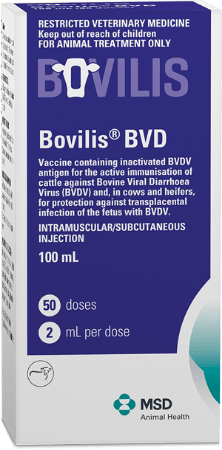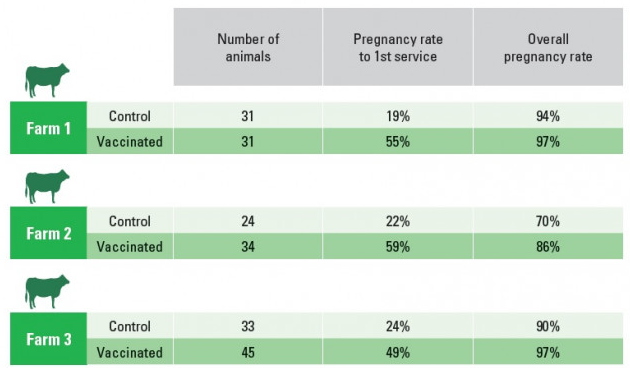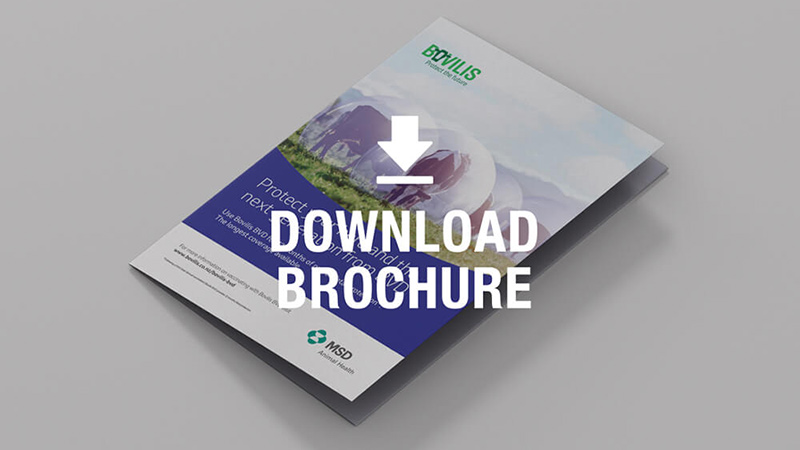
Protect your herd and the next generation.
Use Bovilis BVD for 12 months of proven fetal protection*. The longest coverage available.
The convenience of the longest coverage available along with flexible dosing intervals means you can protect this seasons’ calves no matter when they are conceived by vaccinating with Bovilis BVD.
BVD (Bovine Viral Diarrhoea) is a viral disease of cattle which is wide-spread in New Zealand.
BVD can cause pregnancy loss, diarrhoea, milk drop, and reduced growth rates. It also suppresses the immune system, making animals more susceptible to other diseases, such as pneumonia and salmonella.
*Following a third dose Bovilis BVD provides 12 months fetal protection

Approximately 1 in 20 farms has a BVD incursion each year1.
BVD reduces fertility, milk production and growth rate and costs New Zealand approximately $150 million annually2.
Beef
$41.19
Per mixed-age cow
Per year
OR
$30,893
For a 150-cow farm over
5 years
The largest cost is lost fattening stock
Dairy
$22.22
Per mixed-age cow
Per year
OR
$44,440
For a 400-cow farm over
5 years
The largest cost is lost milk
• 65% of dairy herds screen bulk milk annually for BVD
• 40.6% of bulk milk samples showed the herd had recent or ongoing exposure to BVD (s:p > 0.75)1
Ask your vet about vaccinating with Bovilis BVD.
Bovilis BVD is the only BVD vaccine with a 12 month fetal protection claim*
*Bovilis BVD provides 6 months fetal protection following the initial vaccination series (sensitiser and booster), and 12 months fetal protection following a third dose.
In addition, you gain 12 months duration of immunity for transient infection, so vaccinated cows are also protected3.
Bovilis BVD has a flexible primary dosing interval of 4 weeks to 6 months between the initial sensitiser and booster shots. This extended vaccination interval allows farmers the convenience of aligning your vaccination schedule with other planned management practices.
For more information on BVD in cattle and other related animal health areas, visit TopFarmers.co.nz

Bovilis BVD is made for the predominant subtype in NZ4
Bovilis BVD is made with strain C86, a Type 1a BVD virus which is the predominant subtype in NZ4
- Australian isolates are predominantly subtype 1c5
- The C86 strain and adjuvant in Bovilis BVD are highly immunogenic6,7
- Bovilis BVD provides protection against diverse Type 1&2 BVD viruses, as well as Border Disease viruses6,7
Bovilis BVD offers safety and convenience
No drop in milk production
New Zealand dairy herds are vaccinated when milk production is near its peak, so it’s important that a vaccine has no effect on milk production. A field study has demonstrated no observable difference between vaccinated and control animals following vaccination, and no effect on average milk yields8.
Improves reproduction in herds with active infection9

Bovilis BVD is formulated for safety in pregnant cows
In breeding cattle it is good practice to administer the booster vaccination no less than, but close to 4 weeks before the planned start of mating to ensure fetal protection in early gestation. Bovilis BVD is safe for use in pregnant cows which provides confidence in situations when there is an extended mating period. If any cattle are pregnant at the time of vaccination there will be no adverse effects for the cow or her unborn calf.
When, how?
- 2mL dose by IM (intramuscular) or SC (subcutaneous) injection
- 14 day broach claim (unused vaccine must be discarded within 2 weeks of opening)
- Flexible primary dosing interval of 4 weeks to 6 months between the initial sensitiser and booster shots
- Administer booster vaccination no less than but close to 4 weeks before the start of mating to ensure fetal protection in early gestation
- Safe for use in pregnant cattle and has no adverse effect on milk production
- Nil withhold
- Available in 20mL (10 dose), 50mL (25 dose) & 100mL (50 dose) pack sizes with draw-off tube

References
- MC Gates, JH Han, CA Evans, JF Weston & C Heuer (2019). Assessing the use of diagnostic laboratory accession data to support national bovine viral diarrhoea control in New Zealand. New Zealand Veterinary Journal.
- Han, JH et al (2020). Modelling the economics of bovine viral diarrhoea virus control in pastoral dairy and beef cattle herds. Preventive Veterinary Medicine 182. 105092
- Munoz Bielsa, J. et al. Evaluation of the level of protection afforded by a BVD inactivated vaccine (C-86 strain), 12 months after vaccination. Journees Nationales des GTV, Nantes, 2005, 903
- Horner GW et al. (2000) Typing of New Zealand strains of pestivirus. Surveillance
- Mahony et al. (2005) Genetic analysis of bovine viral diarrhoea viruses from Australia. Veterinary Microbiology 106
- Patel, J.R. et al. (2005) Variation in immunogenicity of ruminant pestiviruses as determined by the neutralisation assay, The Veterinary Journal, Vol 169, 468-472.
- Makoschey, B et al. (2001) An inactivated bovine viral diarrhoea virus (BVDV) type 1 vaccine affords clinical protection against BVD type 2.
- MSD Data on file
- Mawhinney, I., (2005) Vaccination with Bovilis BVD-MD improves fertility in dairy herds under field conditions. Tierärztliche Umschau 60(9):501-502
Health risks & diseases
BVD (Bovine Viral Diarrhoea) is a viral disease of cattle which is wide-spread in New Zealand. Affecting both dairy and beef herds, it is estimated that about half of herds are “actively-infected” with BVD at any given time1 and the cost of BVD to the New Zealand cattle industry is around $150 million a year.2
BVD causes pregnancy loss, diarrhoea, milk drop, and reduced growth rates. It also suppresses the immune system, making animals more susceptible to other diseases, such as pneumonia and salmonella.
Research in New Zealand and overseas shows that it pays to control BVD; it is always more cost-effective to do something than to do nothing3. Moreover, a well-executed BVD control plan will help you achieve other farm goals, like improving animal welfare, reducing antibiotic usage, and improving reproductive performance.
BVD is spread by “persistently-infected” or “PI” cattle. The key to BVD control is therefore to find and eliminate PIs from within your herd, then protect your herd from contact with outside PIs. This can be accomplished by: monitoring the herd, testing individual animals, improving biosecurity, and strategically vaccinating ‘at-risk’ cattle.
For more information about BVD, including how to test for and control BVD click here
For more information visit TopFarmers.co.nz
1 Han, JH et al. (2018). Using Bayesian network modelling to untangle farm management risk factors for bovine viral diarrhoea virus infection. Preventive Veterinary Medicine. 161:75-82.
2 The BVD Management Toolkit. BVD Steering Committee
3 Weir, A. (2016). Epidemiology of BVD in New Zealand dairy herds. Massey University PhD thesis dissertation
For information about prevention with Bovilis® BVD vaccine click here
Bovine Respiratory Disease (BRD) is a complex disorder of cattle causing respiratory disease and even death. It is caused by a combination of infectious agents and stress factors (weaning, transport, mixing, weather extremes, dust, handling and change of diet) acting on susceptible cattle in paddock and more intensive systems.
Signs of BRD include:
- Fever
- Depression
- Loss of appetite
- Dullness
- Coughing
- Rapid, shallow breathing
- Watery, then purulent nasal and/or eye discharge
- Excess salivation
Due to the intensification of farming, BRD may have a larger impact on New Zealand in the future than what we have seen historically. Most cattle are susceptible to BRD at some point, and it can impact performance.
For information about prevention with Bovilis® MH+IBR vaccine click here
Neonatal diarrhoea is arguably one of the most common diseases of newborn calves worldwide. The consequences on animal welfare and those managing the calves can be devastating. The cost of mortality, poor growth and performance as well as treatment costs, all need to be considered. The infectious agents that cause neonatal calf diarrhoea are prevalent in New Zealand. In a recent survey 96% of farms in New Zealand had pathogens that can cause calf scours detected1.
For more information about calf scours and calf health in general click here
For information about prevention with Rotavec® Corona vaccine click here



